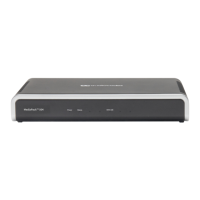SIP User's Manual 66 Document #: LTRT-65415
MediaPack Series
3.3.1.5.3 Self-Signed Certificates
The device is shipped with an operational, self-signed server certificate. The subject name
for this default certificate is 'ACL_nnnnnnn', where nnnnnnn denotes the serial number of
the device. However, this subject name may not be appropriate for production and can be
changed while still using self-signed certificates.
¾ To change the subject name and regenerate the self-signed certificate:
1. Before you begin, ensure the following:
• You have a unique DNS name for the device (e.g.,
dns_name.corp.customer.com). This name is used to access the device and
should therefore, be listed in the server certificate.
• No traffic is running on the device. The certificate generation process is disruptive
to traffic and should be executed during maintenance time.
2. Open the ‘Certificates’ page (see ''Server Certificate Replacement'' on page 62).
3. In the 'Subject Name' field, enter the fully-qualified DNS name (FQDN) as the
certificate subject, and then click Generate Self-signed; after a few seconds, a
message appears displaying the new subject name.
4. Save configuration (see ''Saving Configuration'' on page 169), a
nd then restart the
device for the new certificate to take effect.
3.3.1.6 Management Settings
The Management submenu includes the following:
WEB User Accounts item (see ''Configuring Web User Accounts'' on page 66)
Web Se
curity Settings item (see ''Configuring Web Security Settings'' on page 69)
Telnet/SSH Settings item (see ''
Configuring Telnet and SSH Settings'' on page 70)
WEB & Telne
t Access List item (see ''Configuring Web and Telnet Access List'' on
page 70)
RADIUS Setti
ngs item (see ''Configuring RADIUS Settings'' on page 72)
SNMP setting
s submenu (see ''SNMP Settings'' on page 73)
3.3.1.6.1 Configuring Web User Accounts
To prevent unauthorized access to the Web interface, two Web user accounts are available
(primary and secondary) with assigned user name, password, and access level. When you
login to the Web interface, you are requested to provide the user name and password of
one of these Web user accounts. If the Web session is idle (i.e., no actions are performed)
for more than five minutes, the Web session expires and you are once again requested to
login with your user name and password. Up to five Web users can simultaneously open
(log in to) a session on the device's Web interface.
Each Web user account is composed of three attributes:
User name and password: enables access (login) to the Web interface.
Access level: determines the extent of the access (i.e., availability of pages and read
/ write privileges). The available access levels and their corresponding privileges are
listed in the table below:

